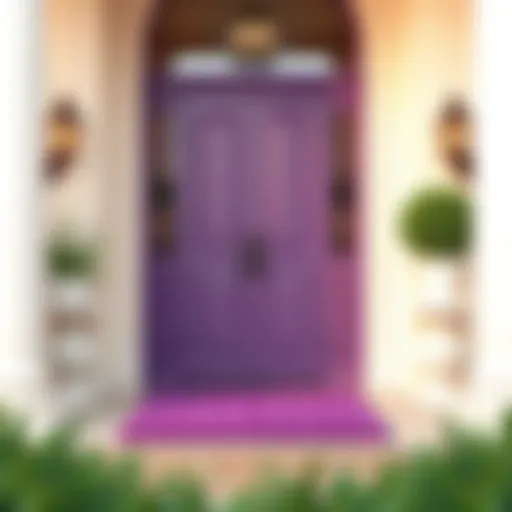Exploring Fake Outdoor Flowers: Style Meets Functionality
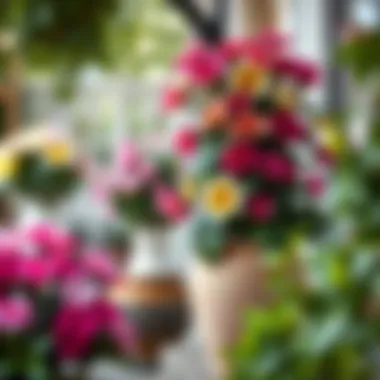

Intro
In a world where outdoor spaces are increasingly turning into sanctuaries of relaxation and aesthetic pleasure, the choice of flora plays a pivotal role in setting the tone. Incorporating fake outdoor flowers in pots is an innovative solution many homeowners, designers, and DIY enthusiasts are exploring. These artificial blooms offer a myriad of advantages that go beyond mere decoration. From providing a constant splash of color year-round to eliminating the hassle of upkeep, faux flowers are emerging as a staple in modern decor.
As we dissect the aesthetics and practicality behind these artificial beauties, we will delve into specific trends, materials, and strategies to enhance your outdoor spaces with flair. This exploration not only busts some common myths associated with faux plants but also sheds light on how they can seamlessly integrate into various design styles, making them a worthy consideration when reimagining your surroundings.
Furniture Styles and Trends
Modern vs. Traditional: Understanding the Aesthetics
When pondering the suitability of fake outdoor flowers, one must consider the existing design framework. Modern decor often embraces minimalism, featuring clean lines and muted colors. Faux flowers in sleek, contemporary pots can enhance this aesthetic by providing a striking contrast without overwhelming the clean design ethos. An option like the simple, white ceramic pot filled with bright, vibrant blooms can add an unexpected burst of life to a stoic outdoor setting.
On the flip side, traditional styles, characterized by elaborate detailing and warm hues, can be complemented beautifully through lush, realistic artificial flowers. Imagine a vintage wicker basket overflowing with faux peonies; it evokes a sense of nostalgia while aligning perfectly with a classic aesthetic.
Color and Material Trends: What's In and What's Out
Selecting the right colors for faux flowers can drastically affect their impact in your outdoor setting. Currently, earthy tones and muted pastels are all the rage, reflecting a desire for harmony with nature. Shades like soft lavender, dusty blue, and even sage green blend well into varied natural surroundings. Meanwhile, the materials used are also significant. High-quality plastics and silk are prevalent and mimic natural textures remarkably well. These materials are resistant to fading and can endure the elements, extending the life of your decor without compromise.
To make a splash with your faux garden display, consider:
- Bold colors: While pastels are trending, vibrant colors can create focal points that draw attention.
- Textural variety: Mixing different materials, like plastic and silk flowers, may create a visually appealing arrangement that plays on light and shadow.
- Container choices: From rustic terracotta to glossy modern finishes, the pot's material can enhance or detract from the flowers' beauty.
At the end of the day, the key is to choose flowers and pots that resonate with your own style while remaining cohesive with the surrounding environment.
"Flower arrangements—real or fake—function as art. When done right, they tell a story without needing a single word."
Transformative Potential of Fake Outdoor Flowers
Faux outdoor flowers aren't simply about aesthetics; they offer practical advantages too. For those lacking a green thumb, these flowers bring the beauty of nature without the need for constant watering, pruning, and care. They also stand up well against unpredictable weather patterns, ensuring your outdoor space remains visually pleasing regardless of the season.
Utilizing fake flowers can also be particularly advantageous for businesses or public areas looking to maintain an appealing exterior with minimal effort. Bars and restaurants, for example, can create inviting spaces with faux flora that draws customers in without the concerns surrounding upkeep.
Preamble to Artificial Outdoor Flora
The integration of artificial outdoor flora into our spaces is not merely a trend; it is a reflection of evolving tastes and practical needs. Homeowners, designers, and DIY enthusiasts alike seek a balance between aesthetics and maintenance in their outdoor arrangements. This makes understanding the world of fake outdoor flowers incredibly valuable. The benefits of incorporating these elements into gardens, patios, and balconies are manifold.
Artificial flowers can provide year-round beauty without the constant care that living plants demand. Imagine a vibrant display of geraniums lasting through winter storms or vibrant daisies thriving in a location where sunlight is scarce. These faux creations strip away the restrictions that live plants impose, allowing for creativity that knows no bounds.
Understanding Fake Outdoor Flowers
Fake outdoor flowers come in various styles, materials, and designs. Today, they are not just simple imitations of nature but rather a sophisticated blend of art and engineering. The faux flowers of today can often fool even the keenest eye, reflecting an accuracy that contrasts sharply against their predecessors that may have looked overly synthetic.
These flowers are typically crafted from materials like silk, polyester, or specially treated plastics, each with its own benefits. While some are designed to imitate the delicate texture of real petals, others may be sturdier, perfect for a high-traffic outdoor area. Their versatility is key: whether arranged in pots on a balcony or scattered throughout a garden, artificial flowers can add a splash of color and warmth to any setting.
To truly understand their value, one must consider how they can be used creatively. For instance, consider a summer barbecue—an arrangement of bright hibiscus and contrasting green leaves can set the perfect scene, all without the worry of wilting in the heat.
Historical Context of Artificial Flowers
The history of artificial flowers is rich and varied. It dates back centuries, with the earliest iterations being crafted from organic materials like feathers, leaves, and even wax. The Romans are said to have embraced these creations, decorating their homes with intricate models. Fast forward to the 19th century, and you’ll find that artificial plants gained a surge in popularity during the Victorian era. These pieces were often crafted from fine silk, showcasing the craftsmanship of that time.
With the advent of synthetic materials in the 20th century, the industry took a significant turn. Plastic and polyester allowed for mass production and greater accessibility. Production methods improved over time, leading to ever more realistic designs that are now available for the modern homeowner.
"The evolution of artificial flowers mirrors society's changing relationship with nature; we now create beauty on our own terms."
In today’s context, contemporary designers and decorators utilize these advancements to create stunning arrangements that enhance various outdoor spaces. As interest in sustainability grows, being able to maintain beauty without harming nature becomes even more compelling.
Embracing the aesthetic and practical dimensions of fake outdoor flowers grants us the freedom to personalize our environments. Homeowners looking to create inviting outdoor spaces can leverage these innovations to breathe life into their surroundings, regardless of ecological limitations or maintenance concerns.
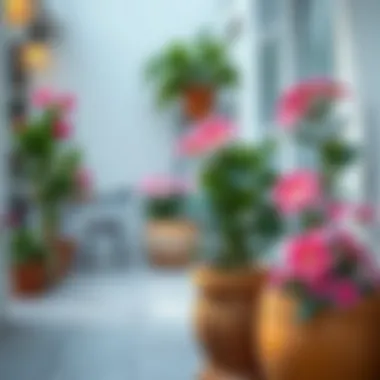

Materials and Construction
The discussion surrounding artificial outdoor flowers cannot stray far from the essential elements of materials and construction. Understanding what goes into creating these faux beauties is crucial to appreciate their practical applications. Each component plays a significant role, influencing durability, aesthetic appeal, and even how they fit into various design schemes. As homeowners, designers, or retailers, a nuanced understanding of these materials will allow for more informed choices when incorporating faux flowers into different settings.
Common Materials Used in Fake Flowers
Plastic
Plastic is perhaps the most ubiquitous material when it comes to artificial flowers, and for good reason. This synthetic alternative offers immense versatility in terms of shapes and colors. One of the standout characteristics of plastic is its resilience to weather elements. Unlike real flowers, plastic can endure everything from harsh sunlight to relentless rain without significant wear. A major benefit of plastic is its affordability; these faux stems are generally cheaper compared to their counterparts made from other materials. However, a drawback could be that they might lack the lifelike appearance that some other materials provide.
Silk
Silk flowers are often touted for their delicate beauty and elegance. The soft texture of silk mimics the feel and appearance of real blooms quite closely, making them a favored choice among many homeowners. What makes silk stand out is its visual gracefulness that can enhance any outdoor setting, potentially elevating the overall aesthetic. However, it’s worth noting that silk tends to absorb moisture, which can lead to fading when exposed long-term to the elements. While they present a higher price tag, the lifelike quality often makes the investment worthwhile for those seeking elegance in their outdoor decor.
Polyester
Polyester has emerged as a preferred option for faux flowers, especially for outdoor use. One of its defining traits is its durability. Polyester fibers can withstand various weather conditions without losing their vibrancy. This material is often mixed with other fabrics to create blooms that look and feel more realistic. Given its resilient nature, polyester flowers generally require minimal maintenance, making them ideal for busy homeowners. However, some might find that they do not quite capture the same level of detail in appearance as silk.
Other Synthetic Fibers
The landscape of materials for artificial flowers is broadening with the use of other synthetic fibers, such as nylon and foam. These materials are being experimented with more frequently due to their unique characteristics. For instance, foam can be shaped into intricate designs that are difficult to achieve with traditional materials. A notable advantage is the lightweight nature of these fibers, allowing for easy handling and rearrangement in decor settings. Yet, they might still be a bit niche when compared to more established options like silk and polyester. Finding the right balance in aesthetic appeal and functionality is key.
Technological Advances in Artificial Flora
Advancements in technology have paved new avenues for the production of artificial flowers. With innovations like 3D printing, manufacturers are able to create intricate, detailed designs that were once painstaking to produce by hand. These technological strides not only improve the aesthetic quality but also contribute positively to sustainability efforts. Synthetic materials can be engineered to be more eco-friendly, appealing to a growing market that values environmental consciousness. This movement pushes towards a newer standard for artificial flowers—where they not only satisfy design needs but also embody a more responsible artistry.
”The blending of art with technology in flower design is reshaping how we perceive artificial flora.”
As the industry evolves, understanding these materials and construction techniques becomes pivotal for anyone keen on integrating these attractive elements into their daily environments.
Design Considerations
Design considerations play a pivotal role when incorporating fake outdoor flowers in pots, as they influence not just the look but also the ambiance of the space. Achieving the right aesthetic can make a significant difference in how an area feels and functions. Careful attention to factors such as color schemes, size and scale, and the variety and arrangement of flowers expands the potential for creativity while also ensuring the artificial flora harmonizes with the surrounding environment.
Selecting the Right Fake Flowers
Color Schemes
The color schemes of artificial flowers are an element that shouldn't be overlooked. They contribute immensely to the overall aesthetic appeal. Colors can evoke emotions, set moods, and even accentuate the architectural features of a space. Choosing vibrant reds and yellows can brighten up a dull balcony, while softer pastels may create a tranquil retreat. One key characteristic of color schemes is their versatility; they allow for seasonal changes—think oranges and browns in fall or cool blues and whites in winter, making them a beneficial choice for outdoor settings.
However, it’s essential to balance multiple hues, as clashing colors can create visual chaos. The main advantage of a well-thought-out color scheme is its ability to tie together various design elements, whether furniture or lighting, creating a cohesive look that feels intentional.
Size and Scale
Size and scale form another crucial aspect of selecting fake flowers. A well-proportioned arrangement can transform the look of any space, making it welcoming or even grand. For instance, taller flowers can create eye-catching verticality, making them suitable for nooks that would otherwise fade into the background. This dimension can add an unexpected twist to a conventional setting.
On the flip side, oversized arrangements can easily overwhelm smaller spaces, blocking views and making them feel cramped. Conversely, petite flowers can look lost in expansive pots. Therefore, understanding both the available space and the intended visual effect is essential to maximizing design potential with artificial flowers. Achieving the right balance can enhance the outdoor area effectively, turning it into a memorable gathering place.
Variety and Arrangement
When it comes to variety and arrangement, the diversity of flowers and how they are placed contributes to an intricate tapestry of visual interest. Mixing different types, such as combining bold peonies with delicate lavender, can enhance the dynamic presented. Furthermore, thoughtful arrangement strategies allow the flowers to play complementary roles, creating depth and texture in the display.
But there’s a fine line when deviating from homogeneity. Too many different styles can lead to confusion, giving the impression that one attempted to cram in too much. It is critical to curate a selection that resonates with the chosen theme while incorporating enough variety to keep it visually appealing.
Integration with Outdoor Spaces
Balconies
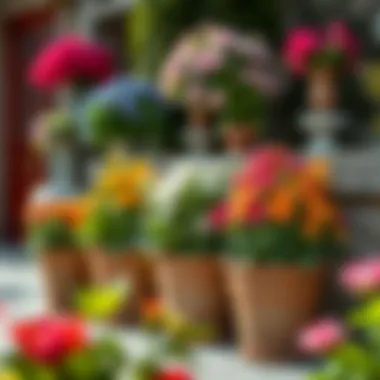

When integrating artificial flowers into balconies, it's crucial to create an inviting atmosphere. Balconies often serve as small escapes from the bustle of daily life; therefore, they should feel cozy and customized. Faux plants can be arranged along the railing, brought together with natural elements, or even positioned to catch the first light of dawn. The key characteristic of balconies is their limited space, making it essential to choose plants that won’t overcrowd but still provide that lush feeling of greenery.
One unique advantage of using artificial flowers here is their resilience—no worries about watering or sunlight requirements, you can place them however you wish without the fuss.
Patios
For patios, the scope for creative expression widens considerably. They often serve as extended living spaces for relaxing and entertaining. Integrating artificial flowers here can create a seamless transition between indoor and outdoor living. Arranging flowers in groupings around seating areas can frame social spaces, encouraging interaction and conversation.
However, take note of the seasonality factor; mismatched flowers in the wrong season may look out of place. The opportunity here lies in creating a year-round bloom without the dependency on weather conditions. Thus, offering great flexibility.
Garden Integrations
Integrating fake flowers into gardens requires a touch of finesse. They can enhance structural elements like fences, or be part of elaborate displays that border genuine plants. This creates layers and visual interest that may not prevail through natural options alone, especially in regions where growth is limited. One crucial aspect is choosing artificial designs that mimic natural foliage closely, which can enhance the garden’s overall authenticity.
While faux flora may lack the scent of real blooms, their durability plays a major role in ensuring a garden's beauty persists irrespective of seasonal challenges. Coupled with sunlight and weather considerations, artificial plants can stand as reliable companions to the natural landscape.
Overall, successful integration of artificial flowers into various outdoor settings not only enhances aesthetic appeal but also saves time and resources while offering flexibility in design choices.
Maintenance and Care
When it comes to integrating fake outdoor flowers into various spaces, understanding the maintenance and care needed for these decorative pieces becomes essential. Unlike live plants that demand watering, sunlight, and nutrient-rich soil, faux flowers offer unique benefits of low maintenance while still delivering aesthetic value. This quality alone makes them a compelling choice for both homeowners and designers alike. Yet, neglect can tarnish their visual appeal over time. Therefore, knowing how to care for these creations ensures that they continue to enhance outdoor spaces without giving away their artificiality.
Care Guidelines for Fake Flowers
To maximize the lifespan and appearance of the fake flowers, it's vital to follow a few straightforward care guidelines:
- Placement Awareness: Avoiding direct sunlight when displaying outdoor flora is crucial. Prolonged exposure can fade the colors, making vibrant blooms look dull and lifeless. Instead, choose spots that provide some shade, unless you intend to rotate the flowers periodically.
- Seasonal Checks: With changing seasons, take a moment to inspect those fake beauties. During winter, harsh climates might lead to potential damage. Therefore, consider bringing them indoors or using protective covers when conditions are severe.
- Dusting Routine: Just like any decorative item in your home, faux flowers attract dust. A gentle dusting every couple of weeks will keep them looking fresh. A soft brush or a cloth can easily do the trick without damaging the delicate fabric.
"Well-cared-for artificial flowers can bring an air of elegance to any setting without the hassle of traditional gardening."
- Occasional Restoration: Even the best-made fake flowers can benefit from a little TLC occasionally. If you notice the petals becoming misshapen or dusty, a quick cleaning or fluffing can work wonders. A little reshaping can breathe life back into them.
These guidelines represent an easy yet essential approach to maintaining faux flowers, ensuring they retain their beauty and utility without the fuss.
Cleaning and Storage Tips
When it’s time to clean and store your faux outdoor flowers, simple practices can lead to prolonged enjoyment:
- Washing Procedures: If your faux flowers require a more thorough clean, it's best to use lukewarm soapy water. Avoid bleach and harsh chemicals as those can deteriorate the material. Gently swish the flowers in soapy water, rinse under running water, and pat them dry with a soft towel.
- Storage Techniques: If you need to store the flowers, ensure they are completely dry first. Placing them in a moisture-free environment helps to prevent mold growth. Consider using acid-free paper between petals to prevent sticking and maintain shape.
- Use of Containers: Employ sturdy containers for storage. Plastic boxes with lids work well as they can be stacked easily without taking too much space. Make sure to label and categorize the flowers based on seasons or colors, facilitating easier access for future use.
- Drying Natural Elements: Should your arrangement include any natural elements, such as twigs or stones, these may need a different kind of care. Avoid washing them, instead lightly brushing off dirt or dust.
By incorporating these cleaning and storage tips into your routine, you can ensure your artificial outdoor flowers look fantastic for seasons to come.
Common Misconceptions
When it comes to decorating outdoor spaces, fake flowers often get a bad rap. Many people hold misconceptions about artificial blooms, leading to a skewed perception of their value and utility. Addressing these misconceptions is crucial because it opens up a world of design possibilities and encourages a more realistic understanding of what these flowers can bring to the table.
The stigma around faux flora often stems from the belief that they are only second-rate options, devoid of the vibrancy and beauty of real flowers. This idea could not be further from the truth. In reality, advancements in materials and design have resulted in artificial flowers that can mimic their live counterparts remarkably well. When properly selected and used, they can be strikingly beautiful and may even outlast natural blooms, especially in harsh outdoor conditions.
Artificial vs. Real Flowers: The Debate
The debate between artificial and real flowers often goes hot and cold. Proponents of real flowers emphasize their intoxicating scents and dynamic growth. They argue that nothing can replicate the authenticity of a blooming plant. However, supporters of artificial blooms point out their practical advantages.
- Longevity: Fake flowers won’t wilt, fade, or succumb to pests. A pristine appearance can be maintained season after season.
- Maintenance: Unlike real plants, which require watering, pruning, and seasonal care, faux flowers need merely a light cleaning every now and again.
- Variety: With artificial options, you can find rare species or unique colors not typically available in local nurseries.
Ultimately, the choice between artificial and real is a personal one. Both have their merits, but understanding the strengths of fake flowers allows one to make informed choices in outdoor decor.
Environmental Considerations
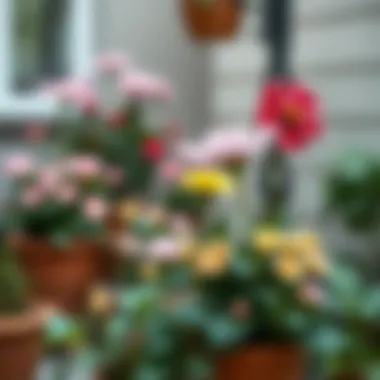

In an age that increasingly prioritizes sustainability, discussions around artificial flowers and their environmental impact are more relevant than ever. Many folks assume fake flowers automatically mean more waste. But when looked at through a different lens, these flora can represent a sustainable practice.
- Durability: Artificial flowers have a long lifespan, leading to less frequent replacements compared to their real counterparts. This reduces the overall environmental footprint.
- Reduced Water Use: By opting for fake flowers, homeowners can save a significant amount of water, especially in regions where drought conditions are a concern.
- No Pesticides: Synthetic flowers don’t require sprays and chemicals, hence mitigating any negative environmental impact on local ecosystems.
However, one must also consider the materials from which artificial flowers are made. Many modern faux flowers are crafted using recycled products or eco-friendly materials, thus aligning with a green ethos. The key takeaway here is that with mindful selection, fake flowers can be both beautiful and environmentally conscious.
"Recognizing the balance between aesthetics and practicality is vital when incorporating fake outdoor flowers into one's decor."
In summary, while misconceptions about fake flowers abound, they shouldn't overshadow the real benefits and possibilities these blooms can offer. By demystifying these beliefs, we can appreciate the true versatility and functionality of artificial flowers in outdoor settings.
Current Trends in Home Decor
The landscape of home decor is continually evolving, shaped not only by the changing tastes of homeowners but also by broader environmental and social currents. In today's society, the charm of nature-inspired aesthetics has taken a backseat to a more sustainable yet stylish living approach. This lays the groundwork for why the integration of fake outdoor flowers in pots has gained traction. Homeowners, designers, and even retailers recognize that these artificial elements offer a practical solution to maintaining an appealing aesthetic without the burdens of real flora.
Integrating faux flowers allows for versatility in design. No watering, no wilting, and most importantly, no fuss. It's a choice that's both functional and aesthetically pleasing. This trend reflects a shift toward a focus on ease alongside visual appeal.
Rising Popularity of Plastic Flora
Plastic flora has gained significant ground as a favored choice in home decor, primarily due to its convenient attributes. Here’s why homeowners and designers are opting for plastic fake flowers:
- Durability: Unlike natural plants, plastic flowers weather environmental conditions effectively. Whether it's the blazing sun or a downpour, they retain their form and color over time.
- Cost-Effectiveness: Investing in high-quality plastic flowers can yield savings in the long run. The absence of ongoing maintenance expenses such as watering, fertilizing, and replacing wilted blooms means fewer trips to nurseries.
- Variety and Selection: The market offers a plethora of designs, allowing for easy customization of style and color to fit any theme. Want a vibrant purple orchid for summer? Or perhaps a subtle cream peony for winter? The options are virtually endless.
Many designers have started placing faux flowers as centerpieces in showroom displays, showcasing how they can elevate spaces. Not to mention, these faux arrangements can be paired with various interior styles, from bohemian to contemporary, ensuring that they are not just an afterthought but rather a statement piece.
Sustainable Practice in Using Faux Flowers
Although the initial impression of faux flowers might not hinge on sustainability, it’s important to highlight their role in eco-friendly decor. In a world that grapples with environmental challenges, employing artificial blooms can be viewed as a prudent, sustainable practice.
- Reduced Water Usage: The water consumption linked to maintaining live plants poses a sustainability issue. Faux flowers require no water, thereby conserving precious resources and making them a smart choice in drought-prone areas.
- Longer Lifespan: With proper care, artificial flowers can last for years, even decades. This longevity contrasts sharply with real plants, which often require replacement due to their inherent lifecycle limitations. Fewer replacements mean less waste.
- Recyclability: Many modern plastic flowers are made from materials that can be recycled, so using them doesn't necessarily contribute to landfill overflow. This paradigm shift, focusing on recyclable materials, encourages responsible consumer habits.
Ultimately, the rise of fake outdoor flowers in pots isn’t just a trend; it’s a reflection of a broader movement towards practicality and environmental consciousness in home decor.
Practical Applications
Understanding the practical applications of artificial outdoor flowers is vital when integrating them into any decor scheme. These floral pieces are more than just aesthetic choices; they carry with them a blend of utility and style that can enhance a myriad of settings. Fake flowers provide individuals with an opportunity to enjoy the beauty of nature without the upkeep that comes with living plants. Homeowners and businesses alike are discovering that these vibrant reproductions can serve many purposes beyond mere decoration.
One of the standout features of artificial flowers is their versatility. They are suitable for various environments and occasions, whether it’s a cozy garden nook, a corporate lobby, or even an upscale event space. Their durability makes them an easy alternative when it comes to adapting decor for seasons or specific themes. For instance:
- Event and Seasonal Decor: Faux flowers can be tailored specifically for events, bringing seasonal themes to life without worrying about wilting or premature decay. Think of elaborate wedding arrangements crafted from delicate silk blooms, perfectly designed to match the color scheme without the fuss of caring for fresh ones.
- Commercial Uses in Businesses: Businesses are increasingly relying on artificial flora to enhance their aesthetic appeal. From restaurants to hotels, faux flowers don’t just beautify a space; they contribute to the overall guest experience. Imagine entering a welcoming lobby decorated with vivid, lifelike arrangements that create a positive first impression, lasting long after the visit.
Moreover, creating a visually appealing environment is key for brand image and customer retention. Considerations also come into play when deciding on the best approaches for incorporating these items. The choice of materials, colors, and arrangements must align with the desired vibe of the space.
There are several benefits tied to the practical applications of fake outdoor flowers:
- Longevity: Unlike their organic counterparts, artificial flowers can withstand the elements better, retaining their appearance and freshness over time.
- Cost-Effectiveness: In the long run, investing in quality faux blooms can prove more economical than regularly refreshing cut flowers.
- Allergy-Free: Using synthetic flowers means no allergy concerns for guests, clients, or family members who are sensitive to pollen.
"Artificial flowers have the ability to complement any decor without the fuss of seasonal changes. This adaptability makes them particularly appealing for both event planners and retailers."
In summary, artificial outdoor flowers embody both functionality and aesthetic enhancement, bridging the gap between beauty and practicality. With creativity and careful thought, they can fit seamlessly into nearly any setting, delivering year-round charm without the messy upkeep that real blooms require.
Finale
Artificial outdoor flowers in pots bring a wealth of advantages, aligning aesthetics with practicality, which is a crucial aspect of home and garden design. They serve not only as ornamental embellishments but as solutions to many challenges that real plants present. When implemented thoughtfully, faux flora can energize any outdoor space, transforming it into a vibrant, welcoming environment at little to no upkeep cost.
The significance of this topic extends into several domains. For homeowners, integrating fake flowers boosts the visual appeal of balconies and patios, ensuring these areas remain lush and inviting year-round, regardless of weather conditions. Designers and retailers benefit from this trend as they can offer more innovative décor options without the constraint of live plant care requirements, thereby elevating their product lines.
Moreover, DIY enthusiasts find value in faux plants, as they allow for creative freedom without the worry of plant maintenance; they can mix and match colors, sizes, and arrangements without fear of wilting or fading, thus encouraging personal expression.
Considerations surrounding the choice and placement of these artificial flowers are vital to ensuring that they enhance the intended space. Mindful selection of materials can impact both aesthetic quality and durability; understanding how to care for them can maintain their appearance for longer periods.
In summary, as discussed in this article, faux flowers in pots present not just a practical solution but also an opportunity to rethink outdoor spaces creatively. By embracing the use of these innovative decorations, individuals can cultivate their surroundings into something unique and inspiring without the trials associated with living plants.
"Artificial flowers can be just as meaningful within the context of design, contributing to beauty and atmosphere without the burdens of care that living plants require."
In this day and age, as the focus shifts towards balance between form and function, the utility of faux outdoor flowers emerges as a smart choice that marries aesthetics with modern practicality.

